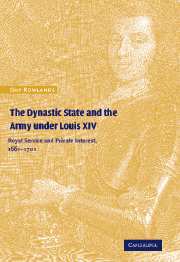Book contents
- Frontmatter
- Contents
- List of maps
- Acknowledgements
- List of abbreviations
- Family tree of the Le Tellier: 1. Principal branch
- Family tree of the Le Tellier: 2. Royal household marital connections
- Map 1 The French provinces under Louis XIV
- General introduction: ‘Absolute monarchy’, dynasticism and the standing army
- Part I ‘Patrimonial bureaucracy’: The Le Tellier dynasty and the Ministry of War
- Part II The forging of the French officer corps and the standing army under Louis XIV
- Introduction
- 6 In the name of sustainability: reforming the structure of the standing army and the officer corps
- 7 The business of a regiment
- 8 The pressures and temptations of service
- Part III The high command of the French armies
- Conclusion: The preservation of the dynasty
- Appendix 1 Defining the grands
- Appendix 2 The proportion of revenue generated by the Extraordinaire des Guerres as a ‘primary receiver’
- Bibliography
- Index
- CAMBRIDGE STUDIES IN EARLY MODERN HISTORY
6 - In the name of sustainability: reforming the structure of the standing army and the officer corps
Published online by Cambridge University Press: 20 May 2010
- Frontmatter
- Contents
- List of maps
- Acknowledgements
- List of abbreviations
- Family tree of the Le Tellier: 1. Principal branch
- Family tree of the Le Tellier: 2. Royal household marital connections
- Map 1 The French provinces under Louis XIV
- General introduction: ‘Absolute monarchy’, dynasticism and the standing army
- Part I ‘Patrimonial bureaucracy’: The Le Tellier dynasty and the Ministry of War
- Part II The forging of the French officer corps and the standing army under Louis XIV
- Introduction
- 6 In the name of sustainability: reforming the structure of the standing army and the officer corps
- 7 The business of a regiment
- 8 The pressures and temptations of service
- Part III The high command of the French armies
- Conclusion: The preservation of the dynasty
- Appendix 1 Defining the grands
- Appendix 2 The proportion of revenue generated by the Extraordinaire des Guerres as a ‘primary receiver’
- Bibliography
- Index
- CAMBRIDGE STUDIES IN EARLY MODERN HISTORY
Summary
From the mid-sixteenth century armies across Europe adapted their military organisation to revolve around the regiment, a unit commanded by a colonel and typically ranging in strength from around 400 to 1,200 men, subdivided into companies each between 30 and 200 strong under a captain. There were other regimental staff officers to assist the colonel, and captains were supported by subalterns. The process began in France in the 1560s, and was taken up by the Dutch a little over twenty years later and in Germany, Britain and parts of northern Italy in the early seventeenth century, though the Spanish Monarchy continued to employ the tercios, larger bands of between 1,000 and 5,000 men, until the eighteenth century. As the seventeenth century unfolded, increasingly large numbers of these regiments were placed on a permanent or semi-permanent footing, and larger regiments might be divided into battalions 400 to 700 men strong for tactical purposes. But prior to the mid-eighteenth century no European state possessed the administrative infrastructure to organise all aspects of company and regimental business. Instead a great deal of room was left for entrepreneurial activity by the officers. Indeed almost no aspect of regimental and company administration was not connected in some way with financial management, and questions of credit were at the heart of this. Notaries even travelled with armies for the convenience of officers.
- Type
- Chapter
- Information
- The Dynastic State and the Army under Louis XIVRoyal Service and Private Interest 1661–1701, pp. 161 - 199Publisher: Cambridge University PressPrint publication year: 2002



